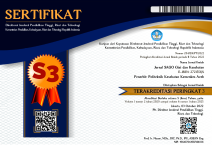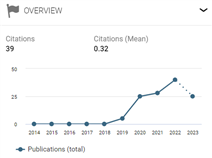The effectiveness of Fibraurea tinctoria as anticancer properties: A literature review
DOI: 10.30867/gikes.v6i1.2342Abstract
Background: Cancer remains a leading cause of mortality globally, necessitating the exploration of natural compounds for therapeutic interventions. Fibraurea tinctoria Lour (FT), an indigenous herb in Asia, has shown potential anticancer properties, but its efficacy and mechanisms require further elucidation.
Objectives: This review aims to synthesize existing literature on FT's anticancer effects, focusing on its bioactive components, mechanisms of action, and the quantitative impact of FT extracts on various cancer cell lines.
Methods: A systematic literature search was conducted using Preferred Reporting Items for Systematic Reviews and Meta-Analyses (PRISMA) criteria across databases including Google Scholar, PubMed, and ScienceDirect, yielding six eligible studies from an initial pool of 321. These studies assessed both in vitro and in vivo effects, differing in extract types, dosages, and treatment durations.
Results: FT extracts exhibited notable antitumor effects, with palmatine hydrochloride (PaH) demonstrating significant inhibitory activity against cancer cell proliferation. Quantitative data indicate that FT extracts can reduce cancer cell viability by 28-82.79%, with PaH-PDT emerging as a promising therapeutic strategy, effectively inducing apoptosis in multiple cancer cell lines.
Conclusion: FT extracts possess substantial anticancer potential, primarily through mechanisms involving DNA damage and apoptosis induction.
Keywords
Full Text:
PDFReferences
Aghaabbasi, K., Askari, N., Kumleh, H. H., Torkzadeh-Mahani, M., & Ramzani-Ghara, A. (2019). The Blepharis persica seed hydroalcoholic extract synergistically enhances the apoptotic effect of doxorubicin in human colon cancer and gastric cancer cells. Molecular Biology Reports, 47, 843–853. https://doi.org/10.1007/s11033-019-04711-z
Ajlan, A. (2016). Medicinal Plants: A Review. Natural Products: An Indian Journal, 12. https://consensus.app/papers/medicinal-plants-a-review-ajlan/8093f71a5b3356449c8dc91b5af0de0b/
Amelio, I., Mancini, M., Petrova, V., Cairns, R. A., Vikhreva, P., Nicolai, S., Marini, A., Antonov, A. A., Le Quesne, J., & Baena Acevedo, J. D. (2018). p53 mutants cooperate with HIF-1 in transcriptional regulation of extracellular matrix components to promote tumor progression. Proceedings of the National Academy of Sciences, 115(46), E10869–E10878.
Aumeeruddy, M. Z., & Mahomoodally, M. F. (2019). Combating breast cancer using combination therapy with 3 phytochemicals: Piperine, sulforaphane, and thymoquinone. Cancer, 125(10), 1600–1611.
Bray, F., Laversanne, M., Sung, H., Ferlay, J., Siegel, R. L., Soerjomataram, I., & Jemal, A. (2024). Global cancer statistics 2022: GLOBOCAN estimates of incidence and mortality worldwide for 36 cancers in 185 countries. CA: A Cancer Journal for Clinicians, 74(3), 229–263. https://doi.org/10.3322/caac.21834
Browne, P., Friedman, K. P., Boekelheide, K., & Thomas, R. S. (2024). Adverse effects in traditional and alternative toxicity tests. Regulatory Toxicology and Pharmacology, 148, 105579. https://doi.org/https://doi.org/10.1016/j.yrtph.2024.105579
Charni, M., Aloni-Grinstein, R., Molchadsky, A., & Rotter, V. (2017). p53 on the crossroad between regeneration and cancer. Cell Death & Differentiation, 24(1), 8–14.
Cho, W. C. (2017). Molecular connections of aging and cancer. Aging and Disease, 8(5), 685.
Correia, J. H., Rodrigues, J. A., Pimenta, S., Dong, T., & Yang, Z. (2021). Photodynamic therapy review: principles, photosensitizers, applications, and future directions. Pharmaceutics, 13(9), 1332.
Cui, Y., Zhou, Q., Jin, M., Jiang, S., Shang, P., Dong, X., & Li, L. (2024). Research progress on pharmacological effects and bioavailability of berberine. Naunyn-Schmiedeberg’s Archives of Pharmacology, 397(11), 8485–8514. https://doi.org/10.1007/s00210-024-03199-0
De la Rosa González, A., Guerra-Ojeda, S., Camacho-Villa, M. A., Valls, A., Alegre, E., Quintero-Bernal, R., Martorell, P., Chenoll, E., Serna-García, M., Mauricio, M. D., & Serna, E. (2024). Effect of Probiotics on Gastrointestinal Health Through the Aryl Hydrocarbon Receptor Pathway: A Systematic Review. In Foods (Vol. 13, Issue 21). https://doi.org/10.3390/foods13213479
Donohoe, C., Senge, M. O., Arnaut, L. G., & Gomes-da-Silva, L. C. (2019). Cell death in photodynamic therapy: From oxidative stress to anti-tumor immunity. Biochimica et Biophysica Acta - Reviews on Cancer, 1872(2), 188308. https://doi.org/10.1016/j.bbcan.2019.07.003
Duan, X., Chen, B., Cui, Y., Zhou, L., Wu, C., Yang, Z., Wen, Y., Miao, X., Li, Q., Xiong, L., & He, J. (2018). Ready player one? Autophagy shapes resistance to photodynamic therapy in cancers. Apoptosis, 23(11–12), 587–606. https://doi.org/10.1007/s10495-018-1489-0
Fathiah, F., Purwaningsih, I., & Suryana, B. (2024). The Flavonoids, Phenolics, and Antioxidant Activity from Ethanol Extract of Fibraurea tinctoria Lour. JURNAL INFO KESEHATAN. https://doi.org/10.31965/infokes.vol22.iss1.1210
Feng, P., Zhu, L., Jie, J., Yang, P., & Chen, X. (2021). The intracellular mechanism of Berberine-induced inhibition of CYP3A4 activity. Current Pharmaceutical Design. https://doi.org/10.2174/1381612827666210715155809
Galadari, S., Rahman, A., Pallichankandy, S., & Thayyullathil, F. (2017). Reactive oxygen species and cancer paradox: To promote or to suppress? Free Radical Biology and Medicine, 104, 144–164. https://doi.org/10.1016/j.freeradbiomed.2017.01.004
Ghareghomi, S., Atabaki, V., Abdollahzadeh, N., Ahmadian, S., & Ghoran, S. H. (2021). Bioactive PI3-kinase/Akt/mTOR Inhibitors in Targeted Lung Cancer Therapy. Advanced Pharmaceutical Bulletin, 13, 24–35. https://doi.org/10.34172/apb.2023.003
Hojo, T., Skarzynski, D. J., & Okuda, K. (2022). Apoptosis, autophagic cell death, and necroptosis: different types of programmed cell death in bovine corpus luteum regression. Journal of Reproduction and Development, 68(6), 355–360. https://doi.org/10.1262/jrd.2022-097
Kessel, D., & Oleinick, N. L. (2018). Cell Death Pathways Associated with Photodynamic Therapy: An Update. Photochemistry and Photobiology, 94(2), 213–218. https://doi.org/10.1111/php.12857
Kim, M. P., & Lozano, G. (2018). Mutant p53 partners in crime. Cell Death & Differentiation, 25(1), 161–168.
Lee, S., & Min, K. (2018). The Interface Between ER and Mitochondria: Molecular Compositions and Functions. Molecules and Cells, 41, 1000–1007. https://doi.org/10.14348/molcells.2018.0438
Lei, Z.-G., Ren, X.-H., Wang, S.-S., Liang, X.-H., & Tang, Y.-L. (2016). Immunocompromised and immunocompetent mouse models for head and neck squamous cell carcinoma. OncoTargets and Therapy, 9, 545–555. https://doi.org/10.2147/OTT.S95633
Majnooni, M., Fakhri, S., Ghanadian, S., Bahrami, G., Mansouri, K., Iranpanah, A., Farzaei, M., & Mojarrab, M. (2023). Inhibiting Angiogenesis by Anti-Cancer Saponins: From Phytochemistry to Cellular Signaling Pathways. Metabolites, 13. https://doi.org/10.3390/metabo13030323
Manosroi, A., Akazawa, H., Akihisa, T., Jantrawut, P., Kitdamrongtham, W., Manosroi, W., & Manosroi, J. (2015a). In vitro anti-proliferative activity on colon cancer cell line (HT-29) of Thai medicinal plants selected from Thai/Lanna medicinal plant recipe database “MANOSROI III.” Journal of Ethnopharmacology, 161, 11–17. https://doi.org/10.1016/j.jep.2014.11.038
Manosroi, A., Akazawa, H., Akihisa, T., Jantrawut, P., Kitdamrongtham, W., Manosroi, W., & Manosroi, J. (2015b). In vitro anti-proliferative activity on colon cancer cell line (HT-29) of Thai medicinal plants selected from Thai/Lanna medicinal plant recipe database “MANOSROI III.” Journal of Ethnopharmacology, 161, 11–17. https://doi.org/https://doi.org/10.1016/j.jep.2014.11.038
Manosroi, A., Akazawa, H., Pattamapun, K., Kitdamrongtham, W., Akihisa, T., Manosroi, W., & Manosroi, J. (2015a). Potent anti-proliferative effects against oral and cervical cancers of Thai medicinal plants selected from the Thai/Lanna medicinal plant recipe database “MANOSROI III.” Pharmaceutical Biology, 53(7), 1075–1081.
Manosroi, A., Akazawa, H., Pattamapun, K., Kitdamrongtham, W., Akihisa, T., Manosroi, W., & Manosroi, J. (2015b). Potent anti-proliferative effects against oral and cervical cancers of Thai medicinal plants selected from the Thai/Lanna medicinal plant recipe database “MANOSROI III.” Pharmaceutical Biology, 53(7), 1075–1081.
Merlin, J. J., Crous, A., & Abrahamse, H. (2024). Combining Photodynamic Therapy and Targeted Drug Delivery Systems: Enhancing Mitochondrial Toxicity for Improved Cancer Outcomes. International Journal of Molecular Sciences, 25(19), 10796.
Moloudi, K., Abrahamse, H., & George, B. P. (2023). Photodynamic therapy induced cell cycle arrest and cancer cell synchronization: review. Frontiers in Oncology, 13, 1225694. https://doi.org/10.3389/fonc.2023.1225694
Muhammad, N., Usmani, D., Tarique, M., Naz, H., Ashraf, M., Raliya, R., Tabrez, S., Zughaibi, T. A., Alsaieedi, A., Hakeem, I. J., & Suhail, M. (2022). The Role of Natural Products and Their Multitargeted Approach to Treat Solid Cancer. Cells, 11(14). https://doi.org/10.3390/cells11142209
Purwaningsih, I., Maksum, I. P., Sumiarsa, D., & Sriwidodo, S. (2023). A Review of Fibraurea tinctoria and Its Component, Berberine, as an Antidiabetic and Antioxidant. Molecules (Basel, Switzerland), 28(3). https://doi.org/10.3390/molecules28031294
Purwaningsih, I., Maksum, I. P., Sumiarsa, D., & Sriwidodo, S. (2024). Isolation and Quantification of Palmatine from Fibraurea tinctoria Lour: In Vitro Antioxidant Activity and In Silico Antidiabetic Activity Evaluation. Drug Design, Development and Therapy, 18, 3443–3459. https://doi.org/10.2147/DDDT.S454091
Qi, F., Sun, Y., Lv, M., Qin, F., Cao, W., & Bi, L. (2019b). Effects of palmatine hydrochloride mediated photodynamic therapy on oral squamous cell carcinoma. Photochemical & Photobiological Sciences, 18, 1596–1605. https://doi.org/10.1039/C9PP00040
Ratour-Bigot, C., Chemidling, M., Montlahuc, C., Abirached, G., Madjlessi, N., Bullier, C., Battistella, M., Bagot, M., Lebbe, C., & Basset-Seguin, N. (2016). Squamous Cell Carcinoma Following Photodynamic Therapy for Cutaneous Bowen’s Disease in a Series of 105 Patients. Acta Dermato-Venereologica, 96(5).
Silva, T. C. da, Silva, J. M. da, & Ramos, M. A. (2018). What factors guide the selection of medicinal plants in a local pharmacopoeia? A case study in a rural community from a historically transformed atlantic forest landscape. Evidence‐Based Complementary and Alternative Medicine, 2018(1), 2519212.
Solnier, J., Zhang, Y., Kuo, Y. C., Du, M., Roh, K., Gahler, R., Wood, S., & Chang, C. (2023). Characterization and Pharmacokinetic Assessment of a New Berberine Formulation with Enhanced Absorption In Vitro and in Human Volunteers. Pharmaceutics, 15. https://doi.org/10.3390/pharmaceutics15112567
Su, C.-R., Ueng, Y., Dung, N., Reddy, V. B., & Wu, T.-S. (2007). Cytochrome P3A4 inhibitors and other constituents of Fibraurea tinctoria. Journal of Natural Products, 70 12, 1930–1933. https://doi.org/10.1021/NP0704248
Sulistiarini, R., Soemardji, A. A., Elfahmi, ., Iwo, M. I., Waluyo, D., & Puspitasari, D. J. (2020). Anticancer Activity of Fibraurea Tinctoria with DLD1 Celline Cytotoxicity Assay. 171–175. https://doi.org/10.5220/0009126401710175
Sulistiarini, R., Soemardji, A. A., Elfahmi, M. I. I., Waluyo, D., & Puspitasari, D. J. (2020). Anticancer Activity of Fibraurea Tinctoria with DLD1 Celline Cytotoxicity Assay.
Sulistiarini, R., Soemardji, A., Elfahmi, Iwo, M., Waluyo, D., & Puspitasari, D. J. (2019). Anticancer Activity of Fibraurea Tinctoria with DLD1 Celline Cytotoxicity Assay. Proceedings of the 2nd Health Science International Conference. https://doi.org/10.5220/0009126401710175
Sullivan, K. D., Galbraith, M. D., Andrysik, Z., & Espinosa, J. M. (2018). Mechanisms of transcriptional regulation by p53. Cell Death & Differentiation, 25(1), 133–143.
Supomo, S., Samarinda, S. T. I. K., Saadah, H., Syamsul, E., & Kintoko, K. (2020). KARAKTERISASI PARAMETER SPESIFIK DAN PARAMETER NON SPESIFIK AKAR KUNING (Fibraurea tinctoria). Jurnal Ilmiah Ibnu Sina (JIIS) Ilmu Farmasi Dan Kesehatan. https://doi.org/10.36387/jiis.v5i2.592
Tran, L., Tam, D. N. H., Elshafay, A., Dang, T., Hirayama, K., & Huy, N. T. (2021). Quality assessment tools used in systematic reviews of in vitro studies: A systematic review. BMC Medical Research Methodology, 21(1), 101. https://doi.org/10.1186/s12874-021-01295-w
Utami, R., Fernando, A., Sari, I. P., & Furi, M. (2017). Determination of berberine content of ethanol extract of root and stem of “sekunyit” (Fibraurea tinctoria Lour) using high performance liquid chromatography (HPLC) method. Jurnal Sains Farmasi & Klinis, 3(2), 115–119. http://jsfkonline.org/index.php/jsfk/article/view/84
Wang, X., Luo, D., & Basilion, J. (2021). Photodynamic Therapy: Targeting Cancer Biomarkers for the Treatment of Cancers. Cancers, 13. https://doi.org/10.3390/cancers13122992
Widuri, S., Sulistyaningsih, Y., Umar, A. H., & Ratnadewi, D. (2024). Secretory structures and histochemistry of roots, stem, and leaves of medicinal plant Fibraurea tinctoria Lour. Microscopy Research and Technique. https://doi.org/10.1002/jemt.24676
Wu, J., Xiao, Q., Zhang, N., Xue, C., Leung, A. W., Zhang, H., Tang, Q.-J., & Xu, C. (2016a). Palmatine hydrochloride mediated photodynamic inactivation of breast cancer MCF-7 cells: Effectiveness and mechanism of action. Photodiagnosis and Photodynamic Therapy, 15, 133–138. https://doi.org/https://doi.org/10.1016/j.pdpdt.2016.07.006
Wu, J., Xiao, Q., Zhang, N., Xue, C., Leung, A. W., Zhang, H., Tang, Q.-J., & Xu, C. (2016b). Palmatine hydrochloride mediated photodynamic inactivation of breast cancer MCF-7 cells: Effectiveness and mechanism of action. Photodiagnosis and Photodynamic Therapy, 15, 133–138. https://doi.org/https://doi.org/10.1016/j.pdpdt.2016.07.006
Wu, J., Xiao, Q., Zhang, N., Xue, C., Leung, A. W., Zhang, H., Xu, C., & Tang, Q. J. (2016a). Photodynamic action of palmatine hydrochloride on colon adenocarcinoma HT-29 cells. Photodiagnosis and Photodynamic Therapy, 15, 53–58. https://doi.org/10.1016/j.pdpdt.2016.05.005
Wu, J., Xiao, Q., Zhang, N., Xue, C., Leung, A. W., Zhang, H., Xu, C., & Tang, Q.-J. (2016b). Photodynamic action of palmatine hydrochloride on colon adenocarcinoma HT-29 cells. Photodiagnosis and Photodynamic Therapy, 15, 53–58. https://doi.org/https://doi.org/10.1016/j.pdpdt.2016.05.005
Wu, J., Xiao, Q., Zhang, N., Xue, C., Leung, A. W., Zhang, H., Xu, C., & Tang, Q.-J. (2016c). Photodynamic action of palmatine hydrochloride on colon adenocarcinoma HT-29 cells. Photodiagnosis and Photodynamic Therapy, 15, 53–58. https://doi.org/https://doi.org/10.1016/j.pdpdt.2016.05.005
Yuan, Y., Li, C., Qiu, S., Yang, C., Zhou, R., & Liu, S. (2024). Exploring the medicinal potential of Dendrobium: Uncovering the spatial distribution of flavonoids and alkaloids in 15 species of Dendrobium using MALDI-MSI. Scientia Horticulturae, 338, 113738. https://doi.org/https://doi.org/10.1016/j.scienta.2024.113738
Zalizar, L., Rahayu, I. D., Sujono, & Nor, Y. A. (2019). Potency of Fibraurea tinctora Lour. extract as anti-bacterial agents towards pathogenic bacteria. IOP Conference Series: Earth and Environmental Science, 293(1), 12026. https://doi.org/10.1088/1755-1315/293/1/012026
Zhang, C., Sui, Y., Liu, S., & Yang, M. (2024). In vitro and in vivo experimental models for cancer immunotherapy study. Current Research in Biotechnology, 7, 100210. https://doi.org/10.1016/j.crbiot.2024.100210
Zhang, Y., Wang, Z., Wang, Y., Jin, W., Zhang, Z.-Y., Jin, L., Qian, J.-C., & Zheng, L. (2024). CYP3A4 and CYP3A5: the crucial roles in clinical drug metabolism and the significant implications of genetic polymorphisms. PeerJ, 12. https://doi.org/10.7717/peerj.18636
Zhang, Y.-T., Yu, Y., Yan, X.-X., Wang, W.-J., Tian, X.-T., Wang, L., Zhu, W., Gong, L.-K., & Pan, G. (2018). Different structures of berberine and five other protoberberine alkaloids that affect P-glycoprotein-mediated efflux capacity. Acta Pharmacologica Sinica, 40, 133–142. https://doi.org/10.1038/s41401-018-0183-7
Refbacks
- There are currently no refbacks.













